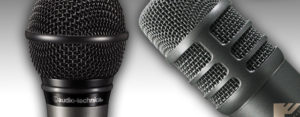Question: What Is a Microphone’s Sensitivity and Why Is It Important To Know?
Answer: Knowing how to read/compare microphone specifications will get you much closer to achieving the sound you want, which is the ultimate goal in capturing audio. Of these specifications, sensitivity (output) is one of many important factors to consider when selecting the correct microphone to use for any given application.

In microphones, sensitivity is the amount of output for a given input.
In most modern audio equipment, microphone input impedance is substantially greater than that of the microphone itself. This input impedance is often 10 times the output impedance of the microphone, and thus may be regarded as an “open circuit.” Audio-Technica typically rates a microphone's sensitivity using this open circuit output voltage, which is the output the microphone will deliver with a stated sound pressure level (SPL) input. This makes the open circuit voltage measurement very useful when comparing microphone sensitivity, maintaining a consistent standard, and achieving accurate sensitivity measurements. For the open circuit output voltage measurement, Audio-Technica uses a reference sound pressure of 1 Pa (Pascal), which is equal to 94 dB SPL. The microphone sensitivity is therefore stated in dB (decibels) as it compares to this reference level.
Because the reference level used is well above the output level of the microphone, the resulting sensitivity specification will be a negative number. The closer this number is to zero, the greater the signal provided to the input terminals. Thus, a microphone with a sensitivity rating of -40 dB is more sensitive than -55 dB, and -55 dB is more sensitive than -60 dB.
Condenser microphones typically have a higher-than-“normal” sensitivity, at least as they compare to dynamic microphones, which usually have a much lower sensitivity. Higher-sensitivity (condenser) microphones can be helpful in lower-SPL applications, such as recording dialogue or vocals. An example is the BP4071 shotgun microphone. The BP4071 has a very narrow polar pattern with a sensitivity of -29 dB (35.5 mV). This means that its sensitivity is high enough to maintain useable output voltage with quieter and/or more distant subjects. This is why microphones with higher sensitivity are more commonly used in broadcast applications, including television production and sporting events. Nevertheless, the limitations of distant miking should still be taken into account.
Not all condenser microphones, however, feature high sensitivity. Take, for example, the AE2500 dual-element cardioid instrument microphone, which combines a condenser and a dynamic element in a single housing. The condenser element for this microphone has a -51 dB (2.8 mV) sensitivity specification, which makes it excellent for kick drum and other higher-SPL applications.
Dynamic microphones, including the dynamic element of the AE2500, typically have a very low sensitivity and excel in high-SPL applications. Similar to its condenser element, the dynamic element for the AE2500 has a -54 dB (1.9v) open circuit sensitivity. Low-output dynamic microphones typically excel in high-SPL applications like miking guitar cabinets, drums, etc. Some other examples of lower-sensitivity dynamic microphones are the ATM230, AE2300, and ATM510.
Hopefully, you now have a better understanding of sensitivity and why it is important to consider when selecting a microphone. As always, feel free to contact the Audio-Technica Audio Solutions Department for more information.